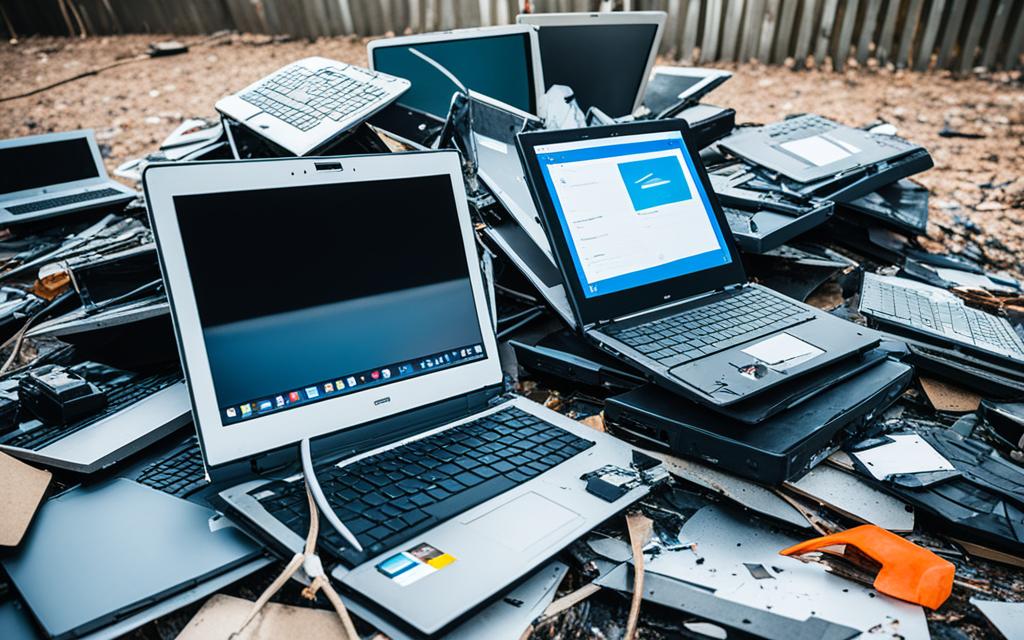The Psychology Behind Laptop Disposal and Consumer Behavior
In today’s fast-paced world, technology is constantly evolving, leading to a high turnover of electronic devices such as laptops. As consumers, we often find ourselves facing the question of what to do with our old laptops. The psychology behind laptop disposal and consumer behavior plays a significant role in shaping the e-waste trends of our society.
Electronic waste, or e-waste, is a growing concern due to its environmental impact and the limited global reserves of valuable resources. Understanding consumer behavior towards laptop disposal is crucial for promoting sustainable practices and achieving a circular economy.
The study of consumer behavior draws from Ajzen’s theory of planned behavior, which suggests that an individual’s attitudes, subjective norms, and perceived behavioral control influence their intentions and subsequent actions. By examining these factors, researchers can gain insights into why consumers choose to recycle their laptops or dispose of them improperly.
Furthermore, e-waste trends are shaped by various psychological factors. Consumers’ awareness of the negative environmental consequences of improper laptop disposal, their beliefs about the recyclability of electronic devices, and their perceptions of the convenience and accessibility of recycling facilities all influence their decision-making process.
This article explores the challenges associated with e-waste, the legislation promoting responsible disposal, and the impact of recycling on sustainability. By understanding the psychology behind laptop disposal and consumer behavior, we can identify opportunities to incentivize and encourage sustainable practices, ultimately making a positive impact on our environment.
Join us as we delve into the complex world of e-waste and discover how our individual choices can contribute to a more sustainable future.
Challenges with E-Waste
Current estimates reveal the staggering volume of e-waste generated globally. Annually, an estimated 44.7 to 50 million tons of e-waste is produced, and this number is expected to increase in the future. Recycling e-waste presents a complex challenge due to its hazardous and non-biodegradable composition, which includes materials such as lead, mercury, arsenic, chromium, cadmium, and plastics.
The improper management of e-waste poses significant environmental risks. When not handled correctly, hazardous materials can leach into the soil and water, causing pollution and threatening ecosystems. Moreover, e-waste often contains valuable components like platinum and silver, making material recovery imperative for resource conservation.
E-waste recycling faces multiple challenges. First, the intricate composition of e-waste requires specialized procedures and technologies to ensure effective recycling. Second, the presence of informal e-recycling systems can hinder the establishment of formal recycling channels and the proper handling of hazardous materials. Third, the international trade of e-waste raises concerns about unethical practices and the transfer of waste to developing countries with less stringent regulations.
“The improper management of e-waste poses significant environmental risks, with hazardous materials leaching into the soil and water, causing pollution and threatening ecosystems.”
Efficient e-waste management is crucial for mitigating the environmental and health impacts associated with improper disposal. By implementing sustainable recycling practices, we can reduce the hazardous impact of e-waste and conserve valuable resources.
| Challenges | Solutions |
|---|---|
| Complex composition of hazardous materials | Investing in advanced technologies for safe recycling |
| Informal e-recycling systems | Establishing formal recycling channels and raising awareness |
| E-waste trade | Strengthening international regulations and monitoring |
The challenges associated with e-waste demand collaborative efforts from governments, businesses, and consumers. Adopting sustainable practices and supporting responsible recycling not only reduces the environmental impact but also contributes to the creation of a circular economy, fostering a more sustainable future for all.
E-Waste Legislation and the Extended Producer Responsibility (EPR) Principle
To address the growing e-waste problem, countries around the world have implemented legislation and policies aimed at effective e-waste management. One notable example is the Waste Electrical and Electronic Equipment (WEEE) Directive introduced by the European Union. This directive focuses on important aspects of waste management, including prevention, reuse, and recycling of e-waste. By creating a comprehensive framework, the WEEE Directive aims to minimize the environmental impact of electronic waste.
A key principle incorporated into e-waste legislation is Extended Producer Responsibility (EPR). Under this principle, manufacturers are held financially accountable for the proper recycling and management of their products, even after they reach the end of their life cycles. EPR encourages manufacturers to design products with sustainability in mind, promoting waste reduction and the use of environmentally friendly materials.
Implementing EPR varies across different countries. Some assign responsibility to local governments, while others establish partnerships between producers and central authorities. Regardless of the approach, EPR serves as a vital tool in incentivizing manufacturers to take responsibility for the entire lifecycle of their products, from production to disposal. By internalizing the costs of recycling and waste management, EPR drives producers to adopt sustainable practices and helps fund proper e-waste management systems.
“Extended Producer Responsibility (EPR) encourages manufacturers to design products with sustainability in mind, promoting waste reduction and the use of environmentally friendly materials.”
E-waste legislation and the implementation of EPR play a significant role in waste management and promote a more circular economy. These measures not only ensure the proper handling of e-waste but also encourage the adoption of sustainable practices throughout the entire value chain. By holding manufacturers accountable for the environmental impact of their products, e-waste legislation and EPR contribute to the goal of achieving a more sustainable and waste-free future.
Benefits of E-Waste Legislation and Extended Producer Responsibility (EPR)
| Benefits | Description |
|---|---|
| Environmental protection | E-waste legislation and EPR help mitigate the negative environmental effects of improper e-waste disposal, such as soil and water contamination. |
| Resource conservation | By promoting recycling and responsible product design, e-waste legislation and EPR contribute to the preservation of valuable resources, reducing the need for raw materials extraction. |
| Sustainable production | EPR encourages manufacturers to adopt sustainable practices, promoting more eco-friendly production processes and reducing overall environmental impact. |
| Job creation | The proper management and recycling of e-waste create employment opportunities in recycling facilities, contributing to local economies. |
| Financial responsibility | Through EPR, manufacturers bear the financial responsibility for the end-of-life management of their products, ensuring a fair distribution of costs. |
Effective e-waste legislation, combined with the principles of Extended Producer Responsibility (EPR), plays a crucial role in waste management and the shift towards a more sustainable future. By holding manufacturers accountable and promoting responsible product design, recycling, and resource conservation, e-waste legislation and EPR contribute to a healthier environment, job creation, and the preservation of valuable resources. As countries continue to adapt and refine these approaches, the global e-waste problem can be successfully addressed.
E-Waste Collection Rates: From Global to Local
E-waste collection rates vary significantly worldwide. While Asia generates the highest amount of e-waste globally, it has relatively low collection rates. On the other hand, Europe boasts higher collection rates compared to the Americas. These disparities in e-waste collection highlight the importance of effective waste management strategies.
The collection and recycling of e-waste contribute to various benefits, including job creation, cost savings, and energy conservation. By properly collecting and recycling e-waste, valuable materials can be recovered, reducing the need for raw materials in manufacturing processes and mitigating the environmental impact of resource extraction.
However, a major challenge in addressing the e-waste problem is the lack of accurate tracking and documentation of e-waste transport and management. Without reliable data, it becomes difficult to develop targeted strategies and initiatives to combat e-waste effectively.
Furthermore, it is worth noting that developed countries, such as the United States, United Kingdom, and European Union, often export their e-waste to developing countries. This practice raises concerns about the ethical and responsible management of e-waste on a global scale.
Regional E-Waste Collection Rates
Table: Comparison of E-Waste Collection Rates by Region
| Region | Collection Rates |
|---|---|
| Asia | Low |
| Europe | Higher than Americas |
| Americas | Lagging behind Europe |
Note: The table above highlights the differences in e-waste collection rates among different regions.
To effectively address the e-waste challenge, it is crucial to improve collection rates globally and establish robust waste management systems. Policymakers, industry stakeholders, and consumers must collaborate to promote responsible recycling practices, raise awareness about the importance of e-waste disposal, and develop innovative solutions for sustainable waste management.
The Psychology of Recycling and Consumer Behavior
Consumer behavior plays a crucial role in promoting recycling behavior and achieving the goals of a circular economy. Understanding the determinants of recycling behavior is essential in designing effective incentives to increase the collection rates of End-of-Life Electrical and Electronic Equipment (EEE).
Several factors influence consumer recycling behavior. Firstly, accessibility plays a significant role. When recycling facilities are easily accessible and conveniently located, consumers are more likely to engage in recycling behaviors. It is essential to provide convenient options for e-waste disposal, such as dedicated collection points or pickup services.
Secondly, knowledge about recyclability plays a key role in consumer decision-making. When consumers are aware of the recyclability of their products and the potential environmental impact of recycling, they are more likely to participate in e-waste recycling activities. Promoting awareness through educational campaigns and product labeling can help inform consumers about the recyclability of their electronic devices.
Belief in the impact of recycling is another determinant of consumer behavior. When consumers perceive that their individual actions contribute to positive environmental outcomes, they are more motivated to recycle. Highlighting the environmental benefits of recycling, such as resource conservation and pollution reduction, can strengthen consumers’ belief in the impact of their recycling behavior.
Incentives play a crucial role in motivating consumers to participate in e-waste recycling. Economic incentives, such as job creation and cost savings, can appeal to consumers who value financial benefits. By emphasizing the economic advantages of recycling, such as the creation of local jobs and the potential for cost savings through the recovery of valuable materials, consumer participation can be increased.
Psychological theories, such as Ajzen’s theory of planned behavior, provide a theoretical framework for understanding and influencing recycling behavior. This theory suggests that individuals’ intentions to recycle are influenced by their attitudes towards recycling, subjective norms (social influences), and perceived behavioral control (perceived ease or difficulty of recycling). By addressing these factors, interventions can be designed to promote positive recycling behaviors.
“Incentives, combined with effective communication and educational campaigns, can encourage positive recycling behavior and contribute to the achievement of a circular economy.”
To further illustrate the determinants of recycling behavior and the impact of incentives, the following table highlights key findings from recent research:
| Determinants of Recycling Behavior | Incentives | Impact |
|---|---|---|
|
|
|
By addressing the psychological determinants of recycling behavior and implementing effective incentives, we can encourage consumers to actively participate in e-waste recycling. Through collective efforts, we can move towards a more sustainable future and achieve the goals of a circular economy.
The Impact of Recycling and E-Waste Disposal
Recycling and proper e-waste disposal have several positive impacts on the environment and society. By recycling materials from e-waste, we can preserve valuable resources and reduce the need for raw materials, thus conserving our planet’s limited resources. This not only helps in sustainable production and consumption but also contributes to the circular economy, where resources are reused and recycled in a closed-loop system.
One of the significant benefits of recycling and proper e-waste disposal is the creation of job opportunities. Recycling facilities require skilled workers to sort, process, and extract valuable materials from electronic waste. By investing in the recycling industry, we can generate employment and support local economies.
In addition to job creation, recycling also leads to substantial cost savings. Extracting materials from e-waste is often more cost-effective than mining and refining virgin resources. Recycling reduces the production costs for manufacturers, enabling them to offer more affordable products to consumers.
Energy conservation is another crucial advantage of recycling and e-waste disposal. Manufacturing products from recycled materials consumes less energy compared to producing goods from virgin resources. By recycling e-waste, we can reduce energy consumption and lower greenhouse gas emissions, contributing to environmental sustainability.
“Recycling turns things into other things, which is like magic.”
— Anonymous
Furthermore, proper e-waste disposal prevents environmental pollution. Electronic devices contain hazardous materials such as lead, mercury, arsenic, and cadmium, which can harm the environment and human health if not handled properly. Recycling ensures the safe extraction and disposal of these hazardous substances, preventing them from leaching into soil and water sources. It also reduces the need for landfill space, as e-waste can take up significant space and release harmful chemicals over time.
We can all contribute to the impact of recycling and e-waste disposal through small actions. By properly recycling our electronic devices and supporting recycling initiatives, we can make a significant and lasting impact on reducing e-waste and its environmental consequences.
Conclusion
Understanding the psychology behind laptop disposal and consumer behavior is crucial in promoting sustainable recycling practices and achieving circular economy goals. The growing concern over e-waste, with its complex composition of hazardous materials, calls for effective management through legislation and policies like Extended Producer Responsibility.
Consumer behavior and incentives play a significant role in influencing recycling rates. By increasing accessibility, knowledge, and belief in the impact of recycling, individuals can be motivated to participate actively in e-waste recycling. It is important to recognize that even small actions can have a profound impact on reducing e-waste and its environmental consequences.
Recycling and proper disposal of e-waste are essential for achieving long-term sustainability and advancing towards a circular economy. By preserving valuable resources, reducing the need for raw materials, and preventing environmental pollution, recycling contributes to job creation, cost savings, and energy conservation. Together, we can make a positive and lasting impact on the global e-waste crisis.
FAQ
What is the psychology behind laptop disposal and consumer behavior?
The psychology behind laptop disposal and consumer behavior refers to the factors that influence individuals’ decisions and actions when it comes to recycling their old laptops. This includes their beliefs, attitudes, knowledge, and motivations towards recycling and sustainable practices.
What are the challenges with e-waste?
E-waste presents several challenges, including its complex composition of hazardous materials such as lead, mercury, arsenic, and plastics, which make it difficult to recycle. E-waste also contributes to environmental pollution when improperly managed. Additionally, there are informal e-recycling systems and e-waste trade that further complicate the recycling procedures.
What is e-waste legislation and the Extended Producer Responsibility (EPR) principle?
E-waste legislation refers to the laws and policies developed by countries to regulate and manage e-waste. The Extended Producer Responsibility (EPR) principle holds manufacturers financially responsible for the proper recycling and management of their products. This principle ensures that producers take responsibility for the entire life cycle of their products and encourages them to design more sustainable and recyclable electronics.
How do e-waste collection rates vary globally?
E-waste collection rates vary by country, with Asia generating the highest amount of e-waste but having low collection rates. Europe has higher collection rates compared to the Americas. E-waste collection and recycling contribute to job creation, cost savings, and energy conservation, while the lack of accurate tracking and documentation poses challenges in addressing the e-waste problem.
What is the psychology of recycling and consumer behavior?
The psychology of recycling and consumer behavior explores the factors that influence individuals’ recycling behavior, such as accessibility, knowledge about recyclability, and beliefs in the impact of recycling. Understanding these determinants can help design effective incentives to increase the collection rates of end-of-life electronic equipment.
What is the impact of recycling and e-waste disposal?
Recycling and proper e-waste disposal have several positive impacts, including job creation, cost savings, and energy conservation. Recycling materials from e-waste helps preserve valuable resources and reduces the need for raw materials. It also prevents environmental pollution caused by improper e-waste disposal, contributing to the circular economy and sustainable production and consumption.















